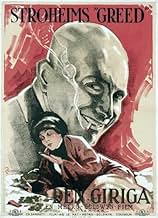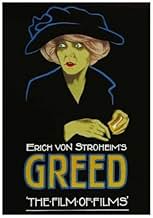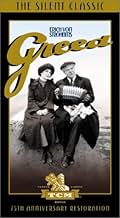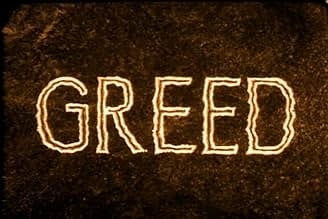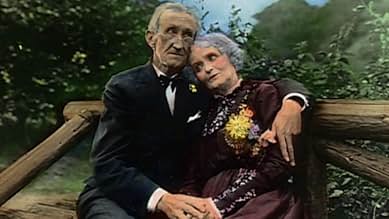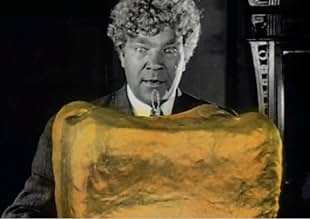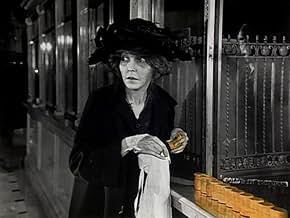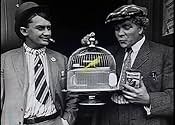VALUTAZIONE IMDb
8,0/10
11.311
LA TUA VALUTAZIONE
L'improvvisa fortuna che ha vinto un fan della lotteria è divenuta così distruttiva rovinando la vita delle tre persone coinvolte.L'improvvisa fortuna che ha vinto un fan della lotteria è divenuta così distruttiva rovinando la vita delle tre persone coinvolte.L'improvvisa fortuna che ha vinto un fan della lotteria è divenuta così distruttiva rovinando la vita delle tre persone coinvolte.
- Regia
- Sceneggiatura
- Star
- Premi
- 3 vittorie totali
Sylvia Ashton
- 'Mommer' Sieppe
- (as Silvia Ashton)
William Barlow
- The Minister
- (non citato nei titoli originali)
Lita Chevrier
- Extra
- (non citato nei titoli originali)
Jack Curtis
- McTeague Sr.
- (non citato nei titoli originali)
Gwendolynne D'Amour
- Undetermined Secondary Role
- (non citato nei titoli originali)
James F. Fulton
- Cribbens - Prospector
- (non citato nei titoli originali)
Edward Gaffney
- Extra
- (non citato nei titoli originali)
Florence Gibson
- Hag
- (non citato nei titoli originali)
James Gibson
- Deputy
- (non citato nei titoli originali)
Oscar Gottell
- Sieppe Twin
- (non citato nei titoli originali)
Otto Gottell
- Sieppe Twin
- (non citato nei titoli originali)
Recensioni in evidenza
I saw the Turner Classic Movies version of this with the still pictures implanted in missing scenes. Although a certain flow is lost, it comes across as a great film. What a shame that so much was destroyed. It tells the story of two pretty good people who should never have got together. Zasu Pitts who looks pretty glamorous at first, is obsessed with money. This obsession ends up destroying her life and McTeagues. There are scenes that are just uncomfortable and others that are horrible. The jockeying for position in the family with the husband willing to bend only so far leads to tragic consequences. Avarice will eventually take one down and Von Stroheim showed this to us. The scene with the two men fighting it out in the desert at the end is one of the most painful ever. Neither can ever hope to survive, yet their fixation on gold goes beyond their love of life. It is so pathetic. Even with all that missing footage, everyone should see this for the masterful presentation of the sick and dying characters. Deep down inside, I've always hoped that someone will open a vault or a supply cabinet, and there will be the rest of Von Stroheim's masterpiece. We can only hope, can't we.
You don't have to watch "Greed" for very long to become impressed with the masterful technique of von Stroheim and his cast. Sometimes it relies on fancy methods such as the occasional use of gold tinting (which must have demanded some painstaking work), and at other times it relies on flawless direction, carefully chosen details, and a keen understanding of what is happening in the characters' lives. The tense finale is especially memorable, a sequence you won't forget for a while.
The only real questions about "Greed" have to do with its length. Hardly anyone disputes the folly of the studio decision to chop the original down to a couple of hours. The restored version uses stills and title cards to fill in the most important scenes that were left out in the studio release, and from this you can also piece together what was actually included in the shorter version. Several significant secondary characters were almost completely eliminated, which took away some of the relationships that were supposed to serve as important comparisons with the central relationship between McTeague and his wife. Even if they had been right to cut the film to a quarter of its length, the choices they made left much to be desired.
Would it really have been better with several more hours of material? Although there is plenty of plot, there isn't anything in the story thematically that would require anything longer then the restored version. It's a gripping study of human flaws, especially greed, but goes no farther. It is admirable to see a director try to hold so closely to a novel, but the Frank Norris novel, while detailed, convincing, and well-conceived as far as it goes, doesn't have the depth or the multi-dimensional characters of the greatest novels. There is no doubt that the lost footage would have provided many more examples of fine film-making, but most of it would not have added very much to the story itself.
What would probably have been perfect is something close to the length of the restored version, with the actual (but now lost) footage instead of the patchwork reconstruction. Since that is impossible, we are very fortunate to have the restored version that includes all of the most important parts of the story and that gives new life to one of the fine classics of silent cinema.
The only real questions about "Greed" have to do with its length. Hardly anyone disputes the folly of the studio decision to chop the original down to a couple of hours. The restored version uses stills and title cards to fill in the most important scenes that were left out in the studio release, and from this you can also piece together what was actually included in the shorter version. Several significant secondary characters were almost completely eliminated, which took away some of the relationships that were supposed to serve as important comparisons with the central relationship between McTeague and his wife. Even if they had been right to cut the film to a quarter of its length, the choices they made left much to be desired.
Would it really have been better with several more hours of material? Although there is plenty of plot, there isn't anything in the story thematically that would require anything longer then the restored version. It's a gripping study of human flaws, especially greed, but goes no farther. It is admirable to see a director try to hold so closely to a novel, but the Frank Norris novel, while detailed, convincing, and well-conceived as far as it goes, doesn't have the depth or the multi-dimensional characters of the greatest novels. There is no doubt that the lost footage would have provided many more examples of fine film-making, but most of it would not have added very much to the story itself.
What would probably have been perfect is something close to the length of the restored version, with the actual (but now lost) footage instead of the patchwork reconstruction. Since that is impossible, we are very fortunate to have the restored version that includes all of the most important parts of the story and that gives new life to one of the fine classics of silent cinema.
10funkyfry
Heavily edited MGM release version of Stroheim's 8 hour epic satisfies at 2 and a half hours -- you have to wonder if any extra length would have made it a little better or a little worse. To be sure, Stroheim probably ran the thing pretty slow when he projected it. Authentic detail in locations adds another level of interest, as we get to see parts of San Francisco, Oakland, and Placer County in the early 20s. The story is dark and involved, detailing the love of two people destroyed by their compulsive greed and neuroses. There is no moment in its story where the viewpoint is not pessimistic, except the image of dual humanity presented in McTeague's birds. Exceptional.
The one great myth about this movie is that it would have been better if it had been four time longer. It's extremely good, at it is highly unlikely that the "unmutilated" version would have been better. In all likelihood, it would simply have been boring. It's a matter of faith among the conventional cinema intellegentia that the studio bosses routinely butchered great films. Judging from the self-indulgent dreck pumped out by unleashed geniuses once the studio system broke down, this is untenable. Stroheim was doubly lucky that the studio cut this film; the cutting made it good and further gave rise to the legend that an even better movie lived in the director's cut.
There was a time, and it was only a few years ago, when I found it difficult to sit through a silent film. The exaggerated movements and facial expressions and the over-bearing music, I believe, turned me off.
However, that changed drastically when I watched von Stroheim's Greed for the first time. The film, simply put, is immaculate. The portrayal of McTeague and Trina is fantastic. Pitts and Gowland, without using their voices mind you, create depth and allow the audience to sympathize with the characters. Silence often acted as a barrier between myself and the characters; here, that distance is bridged by the two actors and, I must assume, von Stroheim's masterful direction.
Yes, the direction is masterful. I believe describing it as such is entirely accurate. Innovative may go too far, but masterful just about covers it. The realism (which shooting on locations benefited) is something to behold. This is a story that Hollywood would balk at depicting in 2004; imagine the row that was had in 1924. Von Stroheim never backs away from his unrelentingly grim vision, reinforcing his theme (money is evil) throughout. And then there is the Death Valley sequence - one of the most marvelous series of scenes committed to celluloid.
All in all, this is truly a fantastic film - one that has aged, due to its ability to treat grim subject matter as it should, much better than many of its contemporaries. Also, it should be noted, that this represents a fine adaptation of Norris' novel McTeague. I was a fan of the novel before I saw the film and the film does not disappoint.
Von Stroheim ensured that the spirit, if not the word, of the novel was maintained.
10/10
However, that changed drastically when I watched von Stroheim's Greed for the first time. The film, simply put, is immaculate. The portrayal of McTeague and Trina is fantastic. Pitts and Gowland, without using their voices mind you, create depth and allow the audience to sympathize with the characters. Silence often acted as a barrier between myself and the characters; here, that distance is bridged by the two actors and, I must assume, von Stroheim's masterful direction.
Yes, the direction is masterful. I believe describing it as such is entirely accurate. Innovative may go too far, but masterful just about covers it. The realism (which shooting on locations benefited) is something to behold. This is a story that Hollywood would balk at depicting in 2004; imagine the row that was had in 1924. Von Stroheim never backs away from his unrelentingly grim vision, reinforcing his theme (money is evil) throughout. And then there is the Death Valley sequence - one of the most marvelous series of scenes committed to celluloid.
All in all, this is truly a fantastic film - one that has aged, due to its ability to treat grim subject matter as it should, much better than many of its contemporaries. Also, it should be noted, that this represents a fine adaptation of Norris' novel McTeague. I was a fan of the novel before I saw the film and the film does not disappoint.
Von Stroheim ensured that the spirit, if not the word, of the novel was maintained.
10/10
Lo sapevi?
- QuizWhile filming the final confrontation in the desert, Erich von Stroheim allegedly shouted several times at actors Gibson Gowland and Jean Hersholt "Hate each other! Hate each other as much as you hate me!"
- BlooperAfter Marcus breaks McTeague's pipe and throws a knife at him, men pull McTeague's tie off as they hold him back. The tie is back in place a moment later as McTeague rushes out of the saloon.
- Citazioni
Title card: GOLD - GOLD - GOLD - GOLD. Bright and Yellow, Hard and Cold, Molten, Graven, Hammered, Rolled, Hard to Get and Light to Hold; Stolen, Borrowed, Squandered - Doled.
- Curiosità sui creditiThe film begins with the "Metro-Goldwyn" logo, and "presented" by Louis B. Mayer. Later the opening credits read "Produced by Metro-Goldwyn-Mayer Corporation Released through Metro-Goldwyn Distributing Corporation". The following year, 1925, Metro-Goldwyn and Louis B. Mayer would merge into Metro-Goldwyn-Mayer.
- Versioni alternativeVersion 5, 16 reels (4,800 meters), edited by June Mathis - According to Jean Mitry who saw it in Paris ("Le romantisme de Stroheim", article in L'Avant-Scène du Cinéma, no. 83-84, July 1968), this version had exactly 4 hours running time. It cut off all derivative stories about supporting characters, concentrating the story on the character McTeague, and adding a number of inter-titles to explain what happened in the deleted scenes. This version was shown in the theatre Studio des Ursulines, Paris, and then the French distributor cut it to a 2 hour film. Cinémathèque Française has a copy of the Mathis' cut - but versions 1 to 4 of the film are considered lost films (1999).
- ConnessioniEdited into Histoire(s) du cinéma: Une histoire seule (1989)
I più visti
Accedi per valutare e creare un elenco di titoli salvati per ottenere consigli personalizzati
- How long is Greed?Powered by Alexa
Dettagli
- Data di uscita
- Paese di origine
- Lingue
- Celebre anche come
- Greed
- Luoghi delle riprese
- 611 Laguna Street, San Francisco, California, Stati Uniti(McTeague's Dental Office)
- Azienda produttrice
- Vedi altri crediti dell’azienda su IMDbPro
Botteghino
- Budget
- 546.883 USD (previsto)
- Tempo di esecuzione2 ore 20 minuti
- Colore
- Mix di suoni
- Proporzioni
- 1.33 : 1
Contribuisci a questa pagina
Suggerisci una modifica o aggiungi i contenuti mancanti


![Guarda Trailer [OV]](https://m.media-amazon.com/images/M/MV5BMDgyZjg5NWUtZDM1Yi00YjE3LWIyNTQtMjIxNzQ0ZmE2ZGE1XkEyXkFqcGdeQXRyYW5zY29kZS13b3JrZmxvdw@@._V1_QL75_UX500_CR0)

